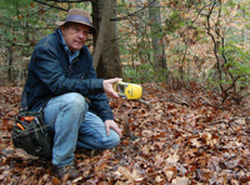Welcome to the Petersburg Project!
PETERSBURG -- The Longest Battle of the American Civil War

Julia Steele and David Lowe have retired from the National Park Service and if anything we say here conflicts with official NPS policies, then we officially no longer much care. We had a good ride with good compatriots. It is time for the youngsters to take over. Our colleague, Dr. Philip Shiman is still working full-time (poor soul) for the US Defense Department in a classified position. We will continue to contribute to the Petersburg Project and hope to bring others on board as co-contributors. We appreciate all of our visitors. Together, we are putting the Siege of Petersburg on the map where it belongs. A siege is basically a battle in slow motion. This one lasted 292 days--the longest battle of the American Civil War.Thanks, David, Julie, and Phil.
 Dr. Shiman assessing the slashing in front of a Confederate gun position, January 2024.
Dr. Shiman assessing the slashing in front of a Confederate gun position, January 2024.
The primary goals of the Petersburg Project are to improve the understanding of trench warfare during the American Civil War, raise public awareness of the significance of entrenched battlefield sites, and promote the documentation, preservation, and interpretation of the surviving earthworks and other relevant [features and] artifacts. To accomplish these goals, we are also seeking new, clearer ways of presenting the information, much of it highly technical, to make it accessible and useful to casual readers and specialists alike. We hope that this website will serve as a testbed for some of these approaches.
The Project's historians and archeologists are using a cross-disciplinary approach involving textual research, field surveys, archeological investigations, and detailed analyses of the contemporary maps and photographs [LiDAR and the powerful analytical capabilities of geographical Information systems (GIS)]. What we do is closely akin to what is commonly known as "battlefield archeology."
The Petersburg Project is a personal endeavor but we always try to cooperate with Petersburg National Battlefield and other elements of the National Park Service, with preservationists, local historians, and with the Civil War Fortification Study Group. So long as the principals are making sense. But the voice here is our own.
The Project's historians and archeologists are using a cross-disciplinary approach involving textual research, field surveys, archeological investigations, and detailed analyses of the contemporary maps and photographs [LiDAR and the powerful analytical capabilities of geographical Information systems (GIS)]. What we do is closely akin to what is commonly known as "battlefield archeology."
The Petersburg Project is a personal endeavor but we always try to cooperate with Petersburg National Battlefield and other elements of the National Park Service, with preservationists, local historians, and with the Civil War Fortification Study Group. So long as the principals are making sense. But the voice here is our own.
 Phil and Dave, Fort Haskell, April 2024.
Phil and Dave, Fort Haskell, April 2024.
Welcome. Please take some time to browse the website using the navigational links at the top of the page AND the Search function which works really well (some topics may be covered in more than one location). There is a lot of material, which we are editing and updating all the time. As of now the structure of the site is rather chaotic but it is expected to improve with age. We have implemented a blog and comment section at and look forward to your input. Thanks for visiting. Y'all come back now ....
updated 4/30/2024



